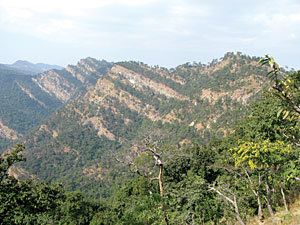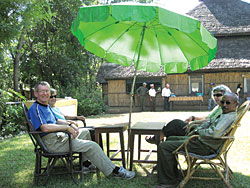 KUNDA DIXIT |
Chitwan's loss is Bardiya's gain. Going by the tourists thronging to Bardiya these days, that is the way it looks.
Chitwan is a world-renowned national park and has become synonymous with wildlife safaris like Kenya's Masai Mara. A key role has been played by resorts like Tiger Tops, which have promoted Chitwan internationally since the 1970s.
However, Tiger Tops and seven other resorts inside Chitwan have been closed since early this year because of a government move to re-evaluate the impact they are having on park ecology. The dispute has been complicated by rivalry between resorts inside and outside the park.
But 450km away, Bardiya National Park has become a beneficiary of Chitwan's closures. Bardiya has only 22 rhinos and 19 tigers and a dozen or so wild elephants, but wildlife viewing is said to be easier here because of the sparse undergrowth.
"Last year this time we had 40 per cent occupancy, this year we are fully booked," says Gauri Mallakar of Tiger Tops Karnali, a branch of Tiger Tops Chitwan. She adds: "Tourists love this place, it has a unique ecology."
Indeed, these days flights to Nepalganj are full of tourists on wildlife safaris to Bardiya, most of them British and American. Nancy Reid from the United States, getting off an elephant after a safari, was breathless with excitement: "It was incredible, we saw rhinos up close, I'm going to come back."
 SURESH RAJ NEUPANE |
More than 500 tourists came to Bardiya in August-October, compared to only 350 at the same time last year. But hoteliers like Mohan Aryal of Forest Hideway Hotel and Cottage says Bardiya could do much better if the government invested in infrastructure.
"Electricity, telephones, direct flights, and bus routes from Pokhara and Kathmandu would double the number of tourists coming here," he says. "We also need more safari elephants."
Tiger Tops's Mallakar says tourists booked to Chitwan came to Bardiya instead and loved it. The resort brought some of its staff to Bardiya too. Maybe they need to bring the safari elephants along too.
Gift to the earth
At the inaugural session of the Global Tiger Workshop held last week, Minister for Forests and Soil Conservation Deepak Bohara announced the government's plans to add 898 square kilometres to Bardiya National Park, effectively doubling its size. Under the proposed plans, Bardiya would extend east towards Dang, taking in hilly terrain (left), with the Mahendra highway as its southern border. At 1866 square kilometres, it would become the largest national park in Nepal.
The expansion of the national park could be a significant boost to tiger conservation efforts in Nepal. An additional 549 square kilometres of forest would be included, while the remainder would be part of a buffer zone. Thirteen VDCs of Dang district will be included. Some 50 additional staff, including army personnel, will be needed to manage the enlarged park.
Back in 2000, the then prime minister Girija Prasad Koirala pledged to double the park's size as a 'gift to the earth', but the deteriorating security situation put the plan on the backburner. Minister Bohara is confident that this time around there will be no such obstacles as the groundwork has been done and funding is available.
Bardiya National Park is home to about 30 species of mammals including the Bengal tiger, the one-horned rhino, wild elephants, swamp deer and black buck.
READ ALSO:
Crocodile cheers - FROM ISSUE #474 (30 OCT 2009 - 05 NOV 2009)
Chitwan resorts closure "fishy" - FROM ISSUE #461 (24 JULY 2009 - 30 JULY 2009)
Bardiya's peace dividend - FROM ISSUE #379 (21 DEC 2007 - 27 DEC 2007


